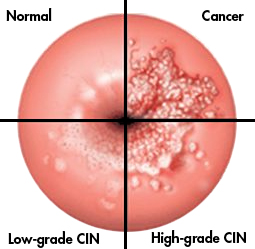Cervical Cancer Causes Diagnosis and Treatment
What is cervical cancer?
Cervical cancer is essentially an outcome of a sexually transmitted disease (STD). It is the third most common gynecologic malignancy worldwide and the eighth most common malignancy among females. The risk of developing cervical cancer is inversely related to the age of first intercourse and directly related to the number of sexual partners on lifetime basis. Important to mention that the risk of developing cervical cancer increases in females whose sexual partners (males) had previous female partners having cervical cancer. It can affect women of all ages and do affect women as young as 20; however, the mean age for developing cervical cancer is about 50 years. About 1% of all cervical cancers show in pregnant women.
Strong association between Human papillomavirus (HPV – types 16, 18, 31, 33, 35, and 39) infection and the development of cervical neoplasia has been confirmed since 1976, as HPV infection increases the risk of neoplasia and is linked to all grades of cervical intraepithelial neoplasia (CIN) and invasive cervical cancer. However, other factors appear to contribute to malignant transformation of cervical hyperplasia. For example, obesity and cigarette smoking are associated with an increased risk of CIN and cervical cancer.
Symptoms
What are the symptoms of cervical cancer
Common symptoms of cervical cancer include:
- Chronic vaginal bleeding
- Palpable lymphatic nodes in the abdomen and pelvis
- Ovaries may be increased by size
- Depression and emotional liability
Causes
What is cervical cancer caused by?
In 70% of cases, cervical cancer and precancerous cervical lesions are caused by infection with human papillomavirus. Other causes include: cervical dysplasia with high circulating estrogen levels and low levels of progesterone, obesity, polycystic ovary syndrome, nulliparity, late menopause, women utilizing an estrogen replacement therapy, estrogen producing tumors, estrogen dependent tumors, anovulation, women with a genetic tendency to cervical or breast cancer (families having more than one female with cervical or breast cancer are at a higher risk to develop it), endometrial hyperplasia and endometrial cancer, women with history of pelvic radiotherapy, infectious diseases especially women with HIV. Women with chronic polyposis.
Treatment
How to treat cervical cancer?
Symptomatic therapy, prolonged synthetic progestin, the decision on a surgical intervention may be approved based on diagnostic results obtained following a diagnostic curettage.
If cervical cancer is confirmed then hemostatic therapy and tight tamponade of the uterus are done, but if this therapy was ineffective then extraperitoneal internal iliac artery ligation is performed, this surgical procedure is used as a golden standard therapy for such patients.
Next steps management
How to diagnose cervical cancer?
- General clinical examination
- Pelvic ultrasound, colposcopy
References
Verified by: Dr.Diab (November 10, 2017)
Citation: Dr.Diab. (November 10, 2017). What is Cervical Cancer? Causes Diagnosis and Treatment. Medcoi Journal of Medicine, 5(2). urn:medcoi:article15636.














There are no comments yet
Or use one of these social networks